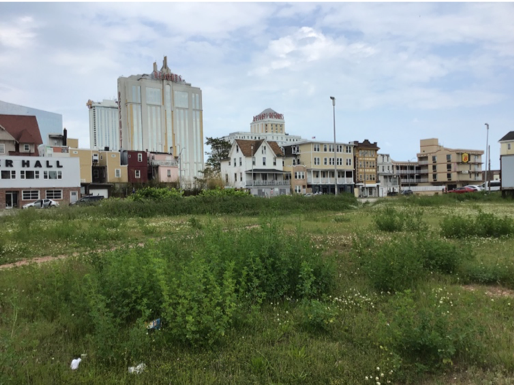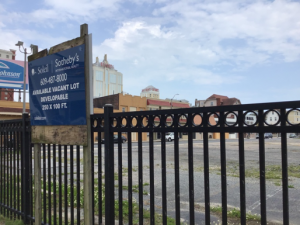
“…. you’ll find the best of the new Atlantic City. What are you waiting for?” –Orange Loop
“The best of what’s old and new in Atlantic City: Beach bars, classic restaurants, and a revival along Tennessee Avenue.” –Philadelphia Inquirer
All across the nation, urban redevelopment and gentrification have been shifting our urban landscapes dramatically. Gentrification and urban redevelopment go hand in hand. Urban redevelopment is the process of physically building, usually accompanied by the process of gentrification, which consists of renovations and buildings stylized via campaigns and rhetoric targeting the tastes, desires, and fears of the liberal middle class wanting to move back in the city. This process is age-old and represents timeless processes of urban transformation. Activist and scholar Jane Jacobs, author of 1969’s The Life and Death of Great American Cities, made a spectacle of city planning theories that concentrate more on how a city looks, rather than strengthening a city through the intricate and working relationships and communities amongst existing residents themselves.
Haven’t things improved since the writing of Jacobs’ 1969 classic? Yes, and no. Cities are still interrelated and intricately bound networks that have been designed many times by racist planning processes, zoning, real estate agencies guided by fears of middle class white Americans. Today, our cities have only become increasingly more polarized and available to the middle and upper class because of the rise and consolidation of our “growth machine”– a political economic concept referring to interlocking elites and companies with the sole purpose of developing to make more capital, thus creating more uneven development in the city. Through this process, more of the true character of cities (culture, affordability, access) are being lost and pushed to the outskirts, while the most vulnerable residents fight to hang on to their livelihood and be apart of the decision-making table. The most vulnerable include people of color, low-income, and senior residents. What is not highlighted in the gentrification debate is the visions that existing residents with agency have for their transforming city. Being a local Stockton University professor and student of the university, we conducted ethnographic research on how socioeconomic changes like gentrification affect the culture of city spaces interactionally based on a case study in Atlantic City, New Jersey. Atlantic City is a city with a 40% poverty rate, and it is one of the most racially diverse cities on the east coast. Gentrification is in the ‘infancy stages‘ in Atlantic City as the city is beginning to build on areas connected to the famous Boardwalk centered around the ‘Orange Loop,’ including Tennessee Avenue which is being modeled off of Philadelphia’s South Street. As the city invited in more of university presence just this past year, we learned about the the effect of gentrification on the bodies of vulnerable and existing residents.Most people don’t readily think about gentrification in terms of how it feels to existing residents. In studies completed by the lead author in San Francisco as well as Atlantic City, many residents feel gentrification through increasing interactions with white residents, increased “town watches,” more dog-walking and jogging and generally feeling unwelcome in new places unaffordable for them to enjoy. Residents feel the lost character of their city through gentrification and growth on an everyday and interactional level within these renewed places (i.e. cafes etc). The process of gentrification can be felt and understood in meetings, in cafes, in breweries fueling and reifying more reminders that those who embody middle-class dollars and values are unwelcome in the new version of the city.
The Atlantic City Story

Residents Envisioning Their Cities
Generally, the pictures of long time residents in mainstream media stories are used to illustrate the “anti-gentrification” camp, and these pictures are convincing. What’s not captured is the real story of what residents imagine in their cities and the cultural clash that accompanies gentrification and redevelopment. Residents want change and transformation but equally want to be apart of that conversation and also want a place in future development. Advertisements and slogans of “new and improved” places either bypass older residents already living there in a kind of Columbus-style or colonial way, or they repackage the culture that was there in ways to promote more consumerism, like in the cases of Atlantic City, New York City, and San Francisco. One resident we talked to from Atlantic City said:
“I hear that the, end result of the [gentrification] process is that the residents are pushed out, just like how it was in other cities. My whole family lives here and some of them probably couldn’t even afford to come to socialize here even though it’s cheaper than most places, but they are struggling to provide for their family…”
Listening to Actual Residents
Residents want the renewal of their cities to focus not solely on development but fixing and strengthening the public infrastructure, funding for their schools, jobs, and particularly in very touristy cities, a focus on affordable amenities for residents who live there year round — a more even kind of development. What the advertising and realities of real gentrification illustrate is the persistent uneven development associated with growing our cities, singling what people with capital are important and what people are not. Longtime and older residents often claim that important to Atlantic City’s growth machine (casinos, entertainment industry, universities) are middle-class tourists who visit the city for an average of six hours, not the residents over 65 whose families have serviced the city for the past decades.“why can’t gentrification fix what’s already here? It’s like their way of fixing is it to change the entire city, hellooo fix the problems on the streets!”
This uneven development can be illustrated through advertisements and aesthetically through the beginning stages of gentrification but also through interactions between residents within new businesses.
Future
Stockton University has moved their island campus to the city. Universities are major contributors to local economies, but also usher in students and student-friendly business creating a whole new feeling of living in the city. Generally, local residents don’t benefit from the expansion of universities nor are accompanying businesses mandated to remain affordable.
What healthy city transformation should include: Accessibility, affordability, and increased quality of life for poor residents of color who have built the city on their backs. Growth minded development is incomplete and disrupts the actual fabric of the city itself — many times, bulldozing community treasures only to be left vacant for years, according to residents of San Francisco and Atlantic City.
—
Recommended Readings:
John Logan and Harvey Molotch. 1988. Urban Fortunes: The Political Economy of Place. California: University of California Press.
P.E. Moskowitz. 2018. How To Kill A City: Gentrification, Inequality and the Fight for the Neighborhood. New York, NY: Nation Books.
Sabiyha Prince. 2014. African Americans and Gentrification in Washington, D.C: Race, Class and Social Justice in the Nation’s Capital. Burlington, VT: Ashgate Publishing Company.
Mindy Fullilove. 2005. Root Shock: How Tearing Up City Neighborhoods Hurts America, and What We Can Do About It. New York, NY: Ballantine Books.
Lance Freeman. 2006. There Goes the Hood: Views of Gentrification from the Ground Up. Philadelphia, PA: Temple University Press.
Thomas Shapiro. 2004. The Hidden Cost of Being African American: How Wealth Perpetuates Inequality. New York, NY: Oxford University Press.
